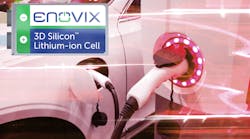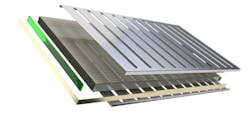This article is part of the TechXchange: EV Battery Management
What you'll learn:
- Details of the "3D Silicon" silicon-anode Li-ion battery.
- What's behind Brakeflow, another advance that enables multiple parallel cell-to-busbar connection.
- Other companies involved in silicon-anode research and development.
A genie grants you wishes. If we had access to one and wanted to create an ideal EV battery, we would ask for high energy density and power, the ability to support many charging cycles without losing capacity, fast charging (as quickly as filling up a gas tank), and stability—and doing it all without the risk of fire.
We don’t know if Fremont, Calif.-based Enovix has come across a supernatural creature who does its bidding, but we do know the silicon-anode, lithium-ion battery development and production company has demonstrated considerable technological acumen of late.
Researchers, for example, have long known that a silicon anode could significantly increase the energy density of a conventional Li-ion battery. While graphite anodes can store about 800 mAh/cubic centimeter, silicon anodes are able to store nearly 1800 mAh/cubic centimeter. Put another way, in graphite anodes, six atoms of carbon are needed to store one lithium ion, so the energy density of these batteries is low.
However, the practical application of Si has been hindered by major challenges: large volume expansion—swelling—during cycling (which can be dangerous in an EV), low electrical conductivity, and instability caused by repeated changes of the Si material’s volume. The volume change is huge, up to around 400%, potentially causing the electrode to fracture and break.
What is 3D Silicon?
Enovix has developed a silicon-anode lithium-ion battery it calls 3D Silicon. The name refers to a proprietary 3D architecture and constraint system, as well as the cells’ 100% active silicon anode.
According to Enovix, its 3D Silicon lithium-ion batteries have demonstrated the ability in 0.27-Ah test cells to charge from 0 to 80% state-of-charge in as little as 5.2 minutes and achieve a greater than 98% charge capacity in under 10 minutes. This quick charging means EV drivers only need to wait a few minutes to “fill up” just as they would at regular gas stations. In addition, with such short charging times, smaller batteries can be used in some EVs, making them more affordable.
"Fast-charge capability can accelerate mass adoption of EVs, and we've been able to demonstrate a level of performance that meets and exceeds many OEM roadmaps," said Enovix CEO, president, and co-founder Harrold Rust.
Overcoming Silicon-Related Issues
As part of the company’s three-year Department of Energy grant program, Enovix is pairing a 100% active silicon anode with EV-class cathode materials. They're built with a proprietary architecture that the company said eliminates many of the problems associated with using silicon as an anode.
A couple of for instances: Unlike a graphite anode, one that’s predominately silicon, can cause a conventional Li-ion cell to experience a large volume expansion upon lithiation (charging). During delithiation (discharging), the cell shrinks. As it does, silicon particles discharge non-uniformly, which causes them to electrically disconnect from current collectors, over-discharge, and pulverize, creating new silicon surfaces and accelerated Li-ion loss in the process.
Enovix said it mitigates this risk with an integrated stainless-steel constraint system surrounding the cell, which limits swelling to as little as less than 2% cell thickness after 500 charging cycles. Also, as a countermeasure, the company developed a “pre-lithiation” process during manufacturing to insert additional lithium to top-off lithium trapped at formation. Its batteries can do this because the added lithium only needs to travel a short distance in the 3D architecture scheme to permeate the anode.
To be fair, it’s important to point out that Enovix has achieved its breakthroughs with a 267-mAh test cell. The company further said the low-capacity cell was only used for chemistry evaluation. Nevertheless, it thinks the concept can be scaled to higher capacities—to the more than 50-Ah capacities used in the automotive industry—without losing any of its qualities.
Testing also demonstrated that after six months at elevated temperatures, Enovix’s batteries had minimal capacity loss. The company said its cells surpassed 1,000 cycles while retaining 93% of their capacity, projecting a calendar life of greater than 10 years.
Fire Safety
When a conventional lithium-ion battery is pierced or severely damaged, a short can occur, discharging the cell in microseconds and potentially releasing a violent and often fiery chain reaction that’s called thermal runaway.
Enovix said that its BrakeFlow technology, an intra-cell system that includes a resistor with a set value, enables multiple parallel cell-to-busbar connections. Busbars are metal bars used to carry large amounts of current. In this case, BrakeFlow regulates current flux from other areas of the battery to the short, thus limiting the short area from overheating and inhibiting thermal runaway.
Other BrakeFlow features:
- Provides better lithium plating protection over graphite anode cells due to a 100% active silicon anode (140-mV higher lithiation potential).
- Enables hotspot reduction and heat dissipation due to its thermal conductivity (nearly 5X cell thermal conductivity compared to similar pouch cells).
- Includes enhanced protection from physical abuse, including crush, pinch, and nail penetration due to its mechanical internal constraint system.
- It’s designed to limit movement of the anode, cathode, and separator due to internal “pinning,” which is a known source of internal shorting in conventional Li-ion batteries.
The company anticipates BrakeFlow will be available in its battery cells in 2023.
Sizing Up the Competition
Enovix isn't the only company investigating the use of silicon as an anode for EV batteries. The U.S. Advanced Battery Consortium (USABC) also announced funding ($3 million) for a similar project from Amprius, which is working on EV batteries with a low-cost, fast-charge silicon nanowire anode.
USABC is a subsidiary of the U.S. Council for Automotive Research LLC (USCAR). Its member companies are Ford Motor Company, General Motors, and Stellantis. Enabled by a cooperative agreement with the U.S. Department of Energy (DoE), USABC’s mission is to develop electrochemical energy-storage technologies that advance commercialization of next-generation EV applications. In support of its mission, USABC has developed mid- and long-term goals to guide its projects and measure its progress.
Another battery company, Enevate of Irvine, Calif., is developing a “5-Minute Extreme Fast Charge Battery Technology for Electric Vehicles” with a driving range of up to 240 miles (390 km). Enevate’s HD-Energy battery technology is said to safely charge and discharge down to −40°C and capture more energy during regenerative braking, extending EV range in cold climates.
According to Enevate, its porous, silicon anode enables the manufacture of industry-standard-size 21700 cylindrical cells, as well as large EV pouch cells for research and customer sampling. The company is backed by automakers Mitsubishi, Nissan, and Renault.
Read more articles in the TechXchange: EV Battery Management


